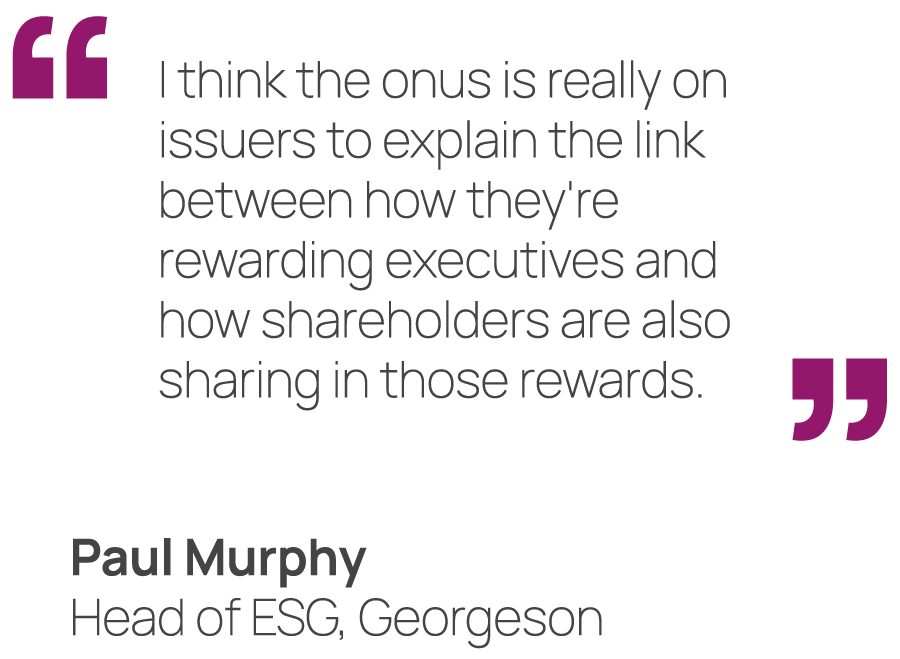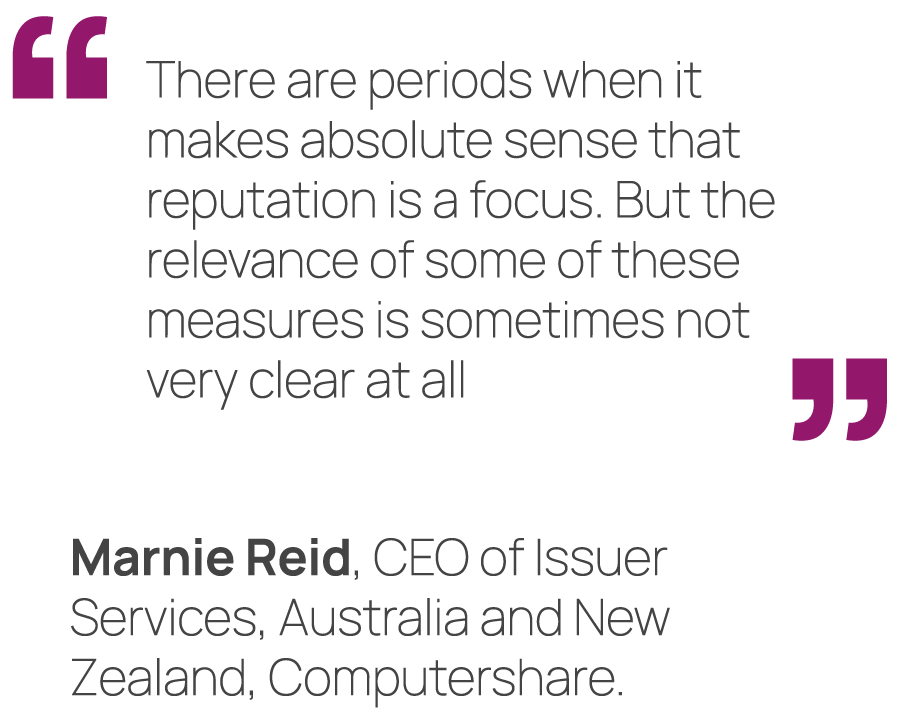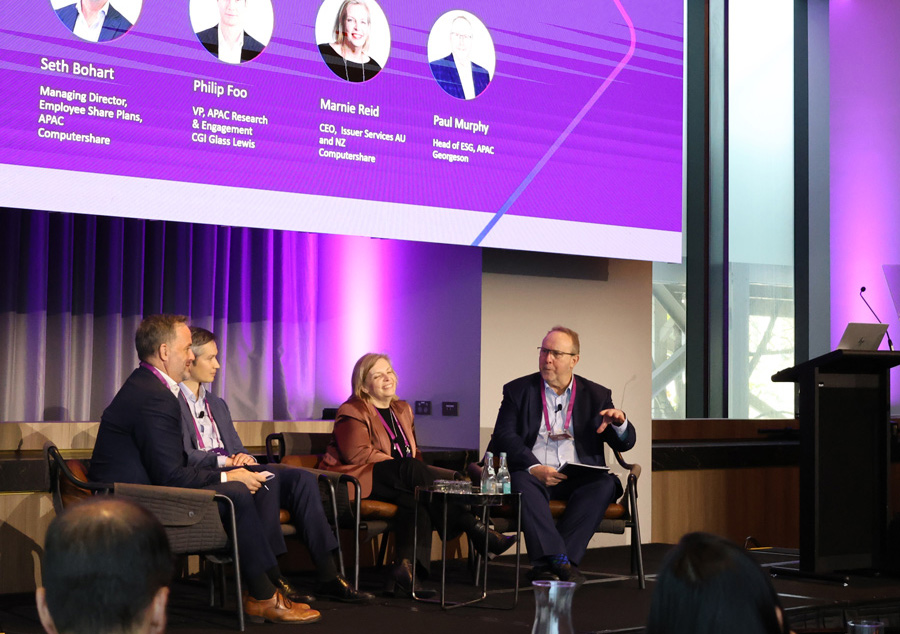With executive remuneration increasingly under scrutiny by investors and the public, incentivisation structures have undergone a revolution.
Among Computershare's employee share plans Australian clients reviewed in 2025, 84% of equity performance hurdles were tied to market performance metrics such as earnings per share (EPS), total shareholder return (TSR), and relative TSR (a comparison against industry peers). 16% were based on non-market performance metrics such as reputation, risk and ESG targets.
In this article, Computershare and a range of experts explore the evolving expectations around executive pay, the growing pressure for transparency, and how companies can better align remuneration with long-term shareholder value.

Seth Bohart
Managing Director, Employee Share Plans, Computershare

Philip Foo
VP, APAC Research & Engagement, CGI Glass Lewis

Marnie Reid
CEO, Issuer Services AU and NZ, Computershare

Paul Murphy
Head of ESG, APAC, Georgeson
A shift from entitlement to accountability
Incentive remuneration for executives was once seen as a reward for completing a tenure, with little regard for performance. However, this static approach has shifted significantly under an increase in scrutiny and investor expectations around corporate governance.
Investors, the public and retail shareholders now expect executive pay to be directly tied to measurable metrics – both market performance and non-market-performance.
This marks a fundamental shift in how remuneration is viewed – not just as a retention or attraction tool but as a signal of corporate values and performance.
In this environment, aligning executive remuneration with long-term shareholder value is more important than ever, says Paul Murphy, Head of ESG, APAC, at Georgeson.
“I think the onus is really on issuers to explain the link between how they're rewarding executives and how shareholders are also sharing in those rewards.”

The importance of ‘skin in the game'
One of the most powerful ways to ensure executives are working towards driving shareholder value is when they remain shareholders themselves.
“Our focus on skin in the game has really increased over the past couple of years,” says Philip Foo, VP, APAC Research & Engagement at CGI Glass Lewis. “We're starting to really encourage minimum shareholding guidelines.”
Computershare’s Seth Bohart, Managing Director, Employee Share Plans, APAC, adds that as employee participation in share plans has increased, it’s more important than ever to clearly communicate what it means to be a shareholder.
“Particularly if something gets picked up in the media – because there's a watchful eye on those reports that go out there,” he adds.
Rethinking non-market performance metrics in executive pay
Among Computershare's client base, non-market performance measures being used in executive remuneration include ESG targets, strategic delivery targets (safety/culture/project/customer), individual performance criteria and risk metrics.
The emergence of non-market performance metrics in executive remuneration resulted from cases where companies suffered significant reputational damage despite strong market results, leaving executives unaffected. A good example of this has been new disclosure requirements for Australia's banking and insurance sectors after the Financial Services Royal Commission a few years back. This highlighted the limitations of solely market-based rewards and mandated the inclusion of non-market measures for many financial institutions.
However, while many companies have introduced ‘reputational' measures to meet these new requirements, many investors find them difficult to link directly to share price performance or other tangible sources of value. They are often seen as vague, particularly after a crisis subsides.
These non-market measures are especially contentious when a company isn't facing a reputational issue, highlights Marnie Reid, CEO of Issuer Services, Australia and New Zealand, at Computershare.

“There are periods when it makes absolute sense that reputation is a focus. But the relevance of some of these measures is sometimes not very clear at all,” she says.
Companies need to be aware that the Remuneration Report (REM report) is heavily scrutinised, being “the most read section in the annual report,” according to Reid, for both employees and retail shareholders.
When justifying the use of non-market metrics, clear, thoughtful communication in the REM report is crucial for aligning executive pay with long-term shareholder value. Murphy recommends a strong and concise cover letter from the Remuneration Committee (RemCo) Chair as part of the REM report to stand out from all the mandatory disclosure material.
“There's the biggest opportunity to actually tell the story and own the narrative – to explain the why, not just the what,” Murphy suggests.
Increasing scrutiny is leading to more strikes
The number of ‘strikes' against REM reports has seen a massive shift in recent years, according to CGI Glass Lewis. Also increasing is the occurrence of second strikes, which make up about a third of the total. A strike occurs when 25% or more of votes are cast against the company's REM Report. If the company incurs strikes at two successive AGMs, they can potentially face a ‘spill' of their entire Board.
As investors demand greater transparency and fairness, they are increasingly opposing remuneration reports when they perceive misalignment with company performance or shareholder interests. This growing focus on accountability has made it harder for companies to justify high remuneration without establishing a clear alignment with shareholders' financial returns.
For example, if an executive is paid a bonus despite the company reporting poor financials or being embroiled in a reputational scandal, shareholders are more likely to see a strike as a way to show their disapproval.
“The number one reason for a strike is where that short-term scorecard just doesn't seem quite right,” Foo explains. Computershare's Seth Bohart, Managing Director, Employee Share Plans, APAC, adds that some high-profile strikes may be more of a “Trojan horse for other reputational issues and scandals” because Australia's unique ‘two strikes rule' can be used by activists or hostile investors as a means of disrupting incumbent boards.
What to do after a strike

Seth, Philip, Marnie and Paul share their insights into executive remuneration best practices at Computershare’s Momentum 2025 event in Melbourne.
If your company has faced a strike, Murphy's number one piece of advice is to “Get out and engage, and listen to what investors are saying,” to ensure issues are rectified within the following year.
“Really unpack why it happened in the first place. There's a big difference between a begrudging support vote for management and a resounding support,” he says. “So don't get too complacent about avoiding if you actually only qualified support from some key investors and proxy advisors last year.”
Bringing together the company's company secretarial, investor relations and remuneration teams to discuss and understand is key to tackling these issues, adds Reid. Plus, plan to stay on the front foot ahead of next year's AGM.
“We're seeing some of the larger organisations in Australia do some really good communication throughout the year, which is engaging people in the broader story of the organisation rather than just at results time, which is very heavily financially driven and is not telling the 'why'.”
Contact us to discover how we can help you align your executive remuneration goals.
Latest News & Insights
- 3 DEC 2025
What is share-based compensation financial reporting and how does it impact company financial statements?
Read More